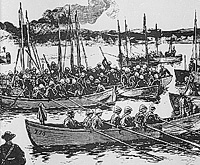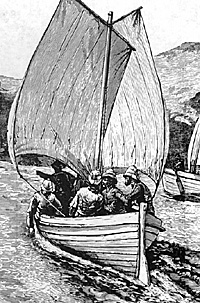NOTE: This article first appeared in SAVAGE AND SOLDIER, Vol. V No. 4.
 Once the British Government decided to send a Relief
Column to rescue General Gordon from Khartoum, the
next most pressing problem was how to transport 7,000
troops with their supplies up the Nile to the frontier.
Once the British Government decided to send a Relief
Column to rescue General Gordon from Khartoum, the
next most pressing problem was how to transport 7,000
troops with their supplies up the Nile to the frontier.
WHALE BOATS ON THE NILE (Note the "Voyagers" on shore in the foreground) THE LONDON GRAPHIC; Nov. 29, 1884.
The journey as far as the Second Cataract was fairly easy. A fleet of large Nile paddle steamers already existed and they were subsequently contracted to carry and/or tow Wolseley's army as far as Wady Halfa, 793 miles south of Cairo. The remaining distance to Korti, the proposed forward base camp, would have to be navigated in some other form of boat.
Remembering his experiences with small boats during the 1870 Red River Campaign in Canada, Wolseley suggested that the troops could ascend the Nile in small sail and man-powered whaleboats. Considerable debate followed, but Wolseley's plan was finally adopted. Once the decision was made, orders were placed in late August 1884, with 47 different British firms for the construction of no less than 800 "whaling gigs", half to be delivered in 30 days, and the other half i n 60 days. The first boats were completed early in September and acceptance trials run in Britain pronounced them suitable for the task at hand.
The boats were not all identical, but they did follow similar plans. The following dimensions come from four different sources:
All of these figures may be correct, as one must remember that the boats were made by 47 different firms. The boats were equipped with two masts each carrying a lug sail on a boom. The sails could be worked while reefed (partially furled) so as to allow the fitting of an awning to protect the men from the sun. The boats were made of lightweight wood (the ILN says fir, while the (London) GRAPHIC states 'white pine'), were painted white, and were numbered consecutively from 1 to 800. The whalers bore their numbers on each side of the bow and on each sail. Additional equipment included twelve oars with oarlocks, a rudder, yoke and tiller, six poles for movement over shallows, and two lanterns-one for the masthead and one for the stern. All boats had white lanterns except for 45 designated as picket boats which carried red lanterns. The estimated cost for each completed boat, with the equipment listed, was 100 Pounds.
| BOAT DIMENSIONS | ||||
|---|---|---|---|---|
| Source | Length | Beam | Depth | Weight |
| Symons | 28' | 5'6" | 2'0" | N/A |
| Stacey | 32' | 6'9"-7'0" | 2'6"-2'8" | N/A |
| Illustrated London News | 30' | 6'6" | 2'6" | 10 cwt |
| London Graphic | 30'-32' | 6'9" | 2'6" | 920 lbs |
The dead-weight cargo of each whaler weighed in at from 6000-7000 pounds. Included in these supplies were 86 provision boxes, each no higher than eight inches (so they could fit under the seats, etc.) and weighing 60 pounds, 1000 pounds of stores and utensils and 600 pounds of ammunition (350 rounds per man on board). Trials in England with the first boats, carrying a full load of equipment, stores and men, gave very favorable results.
Surprisingly, the boats had four inches more freeboard than originally estimated, so it was decided to include even more cargo. Each whaler was now given, in addition to what has already been listed, a 15-man bell tent, a charcoal cooking stove, a filter, fishnets and lines (to provide supplements to the rations from home) and a Flanders cooking kettle with a top that doubled as a frying pan. It is worth mentioning that the 60 pound provision boxes were designed to be stacked along the sides of the boats, between the oarlocks, to provide emergency cover from possible sniper fire. With everything on board it was estimated that the whaleboat and its crew could, if need be, become a fully self-sufficient unit for as long as 100 days.
Each whaler was designed to carry twelve men--10 fully equipped soldiers and either two bluejackets or one sailor and a Canadian "Voyageur." These last men deserve special attention. Wolseley, again remembering his experiences during the Red River Campaign, requested that a force of experienced river men ("Voyageurs" in French-Canadian terminology) be recruited in Canada to help man the Nile whaleboats.
Eventually, 386 men, commanded by Lt.-Col. Denison, a Major in the Canadian Militia and a Toronto Alderman, arrived in Egypt. The force contained not only "true" French-Canadian "Voyageurs", but also businessmen, lumberjacks and Indians. The "Voyageurs" were dressed in dark gray woolen tweed Norfolk jackets, blue flannel shirts, gray trousers, half moccassins and white foreign service helmets. Few of the men wore their wool jackets while on the river, most preferring to work in their flannel shirts with the sleeves rolled up. The helmets were not popular and broad-brimmed felt hats soon replaced most of them. Some men also wore jerseys and blue trousers rather than the prescribed gray.
Officers were issued a uniform of lighter gray material. One "Voyageur" was assigned to each boat to take the rudder, though sometimes they manned the bow with a long pole to push the boat away from the rocks. Whichever position the "Voyageur" was at, the sailor manned the other.
The Canadians worked energetically and successfully, though they complained that the soft wood of the boats made them unsuitable for the task at hand. They also noted that the water of the Nile was so muddy that it rendered the rocks invisible, a strong contrast to their native Canadian rivers. Frederick Villiers, the (London) GRAPHIC's staff artist in Egypt, stated that "there are not many feathers and beads about our Red Indian volunteers ... strong, sturdy looking fellows they are ... they look good enough for any boating requirements."
He went on to say that, "they, of course, have no drill and very little discipline, and they have their own way of putting up tents, which is not quite such a smart performance as that of their English breathren." Despite these drawbacks, the Canadians were considered more than successful. Their skill and nerve at taking the boats through the worst rapids won them continual praise. They were not prone to complain about their work, no matter how exhausting it proved to be. The "Voyageurs" were "thoroughly up in their work and systematic and untiring."
The biggest complaint heard about the Canadian river men was that there were not enough of them--386 to man 800 boats, not an unreasonable complaint.
 WHALEBOATS SAILING UP THE NILE (University of Washington Library)
WHALEBOATS SAILING UP THE NILE (University of Washington Library)
Besides being towed by steamers and proceeding under their own power, the boats were also hauled through particularly rough stretches of the Nile by a mixed force of Kroomen and Dongalese (Sudanese) natives and Egyptian soldiers. From West Africa came 266 Kroomen under the command of Major C.C. Smyth (Welsh Regiment) and Major C.H. Tyndale (2nd West Indian Regiment) to haul the boats over the rapids along with 847 Sudanese natives and 809 Officers, NCOs and men of the Egyptian Army. When sailing on their own, the whaleboats were capable of up to about six knots in a light breeze.
Without a breeze, the normal routine was for six of the ten soldiers to row at any one time. General Wolseley offered a prize of 100 Pounds to the battalion making the quickest passage from the Second Cataract to Korti. The Royal Irish Regiment were the lucky winners.
By mid-December the majority of the force had arrived at Korti and preparations were begun for the splitting of the force into the River Column and the Desert Column. The River Column would continue up the Nile in boats while the Desert Column traded its boats for camels and prepared for its march across the Bayucla Desert.
 THE LONDON GRAPHIC HAD ITS OWN SOLUTION FOR THE NILE TRANSPORT PROBLEMS... AN ALTERNATIVE TO WOLSELEY'S WHALEBOATS. THE LONDON GRAPHIC, SEPT. 20, 1884.
THE LONDON GRAPHIC HAD ITS OWN SOLUTION FOR THE NILE TRANSPORT PROBLEMS... AN ALTERNATIVE TO WOLSELEY'S WHALEBOATS. THE LONDON GRAPHIC, SEPT. 20, 1884.
After the splitting of the Relief Expedition into the two columns, the military exploits of the troops soon overshadowed the whaleboats and the "Voyageurs", who quickly became "old news." Despite their fading from the headlines, the "Whalers of the Nile" form a rather interesting and unique part of the military history of Britain's involvement in Egypt and the Sudan.
SOURCES
Colville, Colonel H. E., History of the Sudan Campaign, Part 1, London, 1888.
Illustrated London News, Sept. 20 and Nov. 29, 1884.
London Graphic, Aug. 30, Sept. 13, Nov. 22 and 29, 1884.
Stacey, C.P., Records of the Nile Voyageurs, Publications of the Champlain Society, Vol. XXXVII, Toronto, 1959.
Symons, J., England's Pride, London, 1965.
ED NOTE: Here is the chance for some enterprising reader to build some of the whaleboats for his colonial games. THE COURIER would like to print a SAPPER'S REPORT describing the construction of such a model. Remember articles must be typed double space and photos (B & W) as well as line drawings are essential for such a topic -- DICK BRYANT
More Sudan
-
The Sudan: Introduction: The Mahdi
The Sudan: First British Involvement 1884-85
The Sudan: Anglo-Egyptian Sudan Map
The Sudan: Illustration: Troop Types of Hicks' Expedition (slow: 139K)
Sudan War Bibliography
Lynn Bodin: Bio of Theme Editor for Sudan
Whalers on the Nile: Sudan Transport Boats
Wargame Figures for the Sudan
Colonial Era Wargame Rules Overview
Back to Table of Contents -- Courier Vol. V #2
To Courier List of Issues
To MagWeb Master Magazine List
© Copyright 1984 by The Courier Publishing Company.
This article appears in MagWeb (Magazine Web) on the Internet World Wide Web.
Other military history articles and gaming articles are available at http://www.magweb.com